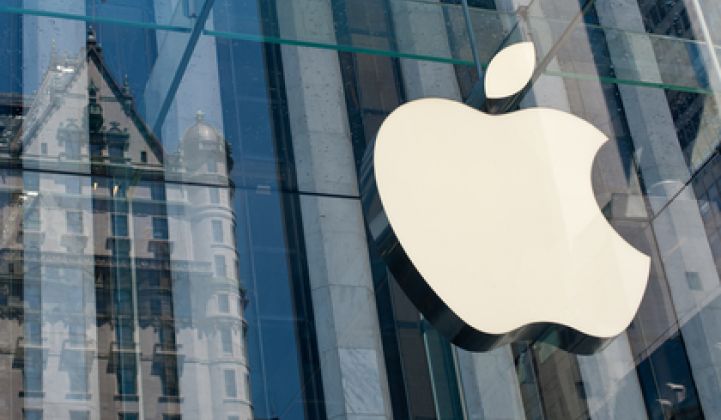This month, Apple did something unprecedented in its history.
No, it didn't set an iPhone sales record, or launch a new form of artificial intelligence. It was something much simpler -- and to the average consumer, completely invisible.
Apple became an energy supplier.
The tech giant now owns hundreds of megawatts of photovoltaics projects in Arizona, California and Nevada. With such a big (and growing) portfolio of projects, Apple needed the ability to sell renewable electricity and grid-balancing services into regional wholesale markets across the country. Federal regulators granted them approval in early August. Thus, Apple Energy was born.
The move itself is not unprecedented. Google did the same thing back in 2010 as it ramped up wind investments to supply its offices and data centers. But the birth of Apple Energy comes amidst a radical change in the way large commercial businesses are procuring their power.
"It’s all part of this much broader trend that is really starting to pick up," said Dave Cherney, an energy and utilities expert at PA Consulting Group.
The Rocky Mountain Institute's corporate renewable energy deal tracker illustrates how dramatically the market has changed in recent years. In 2012, Google was basically the only major buyer in the U.S., accounting for a half-gigawatt worth of wind contracts. The market swelled to 3,230 megawatts in 2015, driven by a much broader group of corporate buyers.
![]()
Source: Rocky Mountain Institute
Some of those contracts were signed through utility green-tariff programs. But many of the contracts were brokered directly with project owners -- or, in a more recent trend, the projects were owned directly by the corporation itself.
On the more extreme end of the trend are full-on corporate customer defections. In Nevada, for example, MGM Resorts recently filed to end its relationship with Nevada Power (just for buying energy; it will still use the utility's poles and wires) in order to go procure renewables on its own. MGM, which represents roughly 5 percent of Nevada Power's demand, is willing to pay an $87 million penalty to buy its own power. Wynn Resorts and the Peppermill Casino have followed suit.
"The remarkable thing is that they're clearly willing to pay a premium to do this," said Cherney, referring to the Nevada companies looking to cut ties with their traditional utility suppliers. It's all the more remarkable because Nevada Power's parent, NV Energy, had already created a green tariff program after a large data center company threatened to leave. That didn't seem to be enough for some customers.
One assumption to draw from that willingness to pay steep fees: Big companies think they'll be able to get renewable power for cheaper on their own.
Cherney and PA Consulting found a trend similar to the one identified by RMI. When looking at non-utility companies, Cherney found roughly 1,500 signed contracts for renewable generation. Renewable procurement in all kinds of markets is picking up pace. "A number of these customers are starting to figure out this space," he said.
In a sense, regulated utilities are starting to deal with the same problem that power providers in deregulated markets have long faced: customer churn.
Corporations now have more options for buying power straight from third-party renewable energy developers and managing their on-site energy use using third-party tools. That doesn't mean large commercial and industrial customers are just going to walk away en masse, but regulated utilities will most certainly see their relationships with big customers erode -- unless they take a comprehensive approach to rethinking their offerings.
"This is larger than simply clean energy. It's about utilities focusing on understanding the customer," said Cherney.
The trend also transcends the domain of corporate customers. An increasing number of towns and cities across the U.S. are looking to procure power on their own as well. In a world where nearly every product and service is becoming customizable, utilities are finally being forced by their buyers to create more flexible (and cleaner) offerings.
In a recent white paper on the next-generation utility customer, PA Consulting identified the need for a new customer-centric approach to engaging customers. “There is a rich opportunity for utilities to proactively determine their long-term business and customer strategy by taking a horizontal view of customers,” wrote PA.
That could mean better segmenting customers and identifying their needs, building new energy service arms, tailoring green tariff programs, and partnering with third parties -- basically, doing anything necessary to give customers what they want.
"The next-generation utility is going to think through these new types of demands in a much more detailed way," said Cherney. "What are the reasons customers are trying to defect? What are their needs? It's a new issue for some utilities, and they're wrestling with it."
A utility like NV Energy, which is seeing some of its biggest customers defect all at once, can learn from deregulated markets where competitive suppliers have long battled for customers. In a new era of customer choice and cheap renewable energy, anything goes.
"This is not a death spiral for a regulated utility like NV Energy, but it is a significant challenge," said Cherney. "It's certainly not an easy thing to wrap your arms around."



